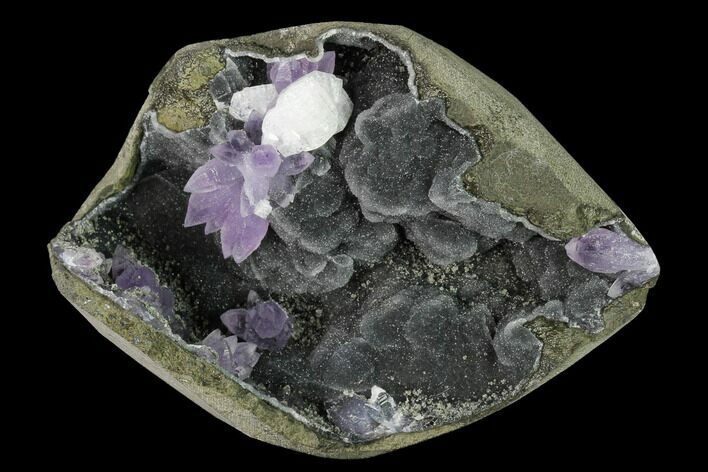This Specimen has been sold.
3.5" Amethyst Crystals on Sparkling Quartz Chalcedony - India
This is a stunning, 3.5" wide specimen that features amethyst crystals that formed over druzy quartz chalcedony, collected from Madhya Pradesh, India. This formation occurred within a cavity/vug in the basalt host rock. Apophyllite, barite, chabazite and julgoldite crystals have also been reported as being present within some of these vugs. Based on the luster and striations of the additional colorless crystals within this cavity, it is likely that they're apophyllite.
It comes with an acrylic display stand.
It comes with an acrylic display stand.
Amethyst is a purple variety of quartz (SiO2) that owes its violet color to natural gamma irradiation, iron impurities, and the presence of trace elements, which result in complex crystal lattice substitutions. It is considered a semi-precious gemstone, and just two centuries ago was considered to have a value on par with diamonds, sapphires, and rubies. The largest and best known amethyst deposits occur in southern Brazil and Uruguay, where they are found in hydrothermally-formed geodes, but many localities around the world produce an amazing variety of amethyst crystals and formations. They are almost always formed in medium- to high-temperature geological settings.
Chalcedony is any microcrystalline variety of silica composed of very fine intergrowths of quartz and mogánite: microcrystalline minerals have microscopic crystals that cannot be observed by the naked eye. Both quartz and mogánite have the same chemical formula SiO2 (silicon dioxide), but different crystal structures. When free from impurities, chalcedony is colorless and transparent. Depending on impurities present during formation, chalcedony can form in a wide variety of colors including red, yellow, green, blue, purple, grey, white, and numerous hues in between. Chalcedony is quite hard at 7 on the Mohs Hardness Scale: this matches its main component quartz, which is the benchmark mineral for the scale at 7.
SPECIES
Quartz var. Amethyst & Quartz var. Chalcedony
LOCATION
Khadakwani, Madhya Pradesh, India
SIZE
3.5 x 2.5"
CATEGORY
SUB CATEGORY
ITEM
#168764
 Reviews
Reviews















